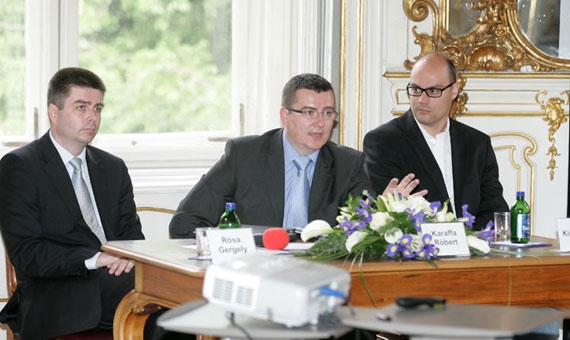Carl Zeiss has been revolutionizing the eyeglass market since April 1, 1912 when it introduced PUNKTALŸ, the first precision eyeglass lens. The German company’s lens plant can be found in Mátészalka, Northeast Hungary.
“In fact, 2012 marks a double anniversary, as the Carl Zeiss Vision Hungary Kft. (CZVH) became a subsidiary of Carl Zeiss Vision group 20 years ago,” said Róbert Karaffa, CEOof CZVH, at a press conference organized on May 22.
“The manufacturing plant in Mátészalka has more than 430 employees and supplies mass manufactured plastic and mineral lenses and prescription-lenses to nearly 20 countries. Mineral lenses are made in Hungary, exclusively,” the CEO continued. “Besides, CZVH is a significant supplier of domestic opticians and spectacle-maker shops.”
Carl Zeiss retrospective
The lens Carl Zeiss developed a hundred years ago enabled crystal clear vision for the first time regardless of the viewing direction. In 1935, the company patented the durable anti-reflective coating on optical surfaces which has been increasing the light transmission of the lenses and improving the vision of wearers since 1959. Beginning in 1970, the eyeglass lens manufacturer offered self-tinting lenses developed with its sister company Schott. In 1979 Carl Zeiss introduced a visual aid based on the Keplerian telescope which featured 3.8x magnification for those with severe visual impairments.
Carl Zeiss today
The company continuously addresses improving the performance and wearing comfort of glasses: this includes progressive lenses, thinner and lighter lenses and new coatings that repel dirt and make the lenses more scratch resistant. Nowadays, precise measurements and manufacturing techniques enable the production of lenses that are as individual as eyes. 200 million people around the world wear glasses with lenses from Carl Zeiss, with two additional wearers every second. They all benefit from the company's products and technologies that have been revolutionizing vision for 100 years. According to Gergely Rósa, commercial manager of CZVH, with half of the Hungarian population in specs, plus a few hundred thousands of Hungarians wearing contact lenses, quality must be the most important factor in lens manufacturing.
With its innovative technologies and leading-edge solutions, Carl Zeiss is also successful in the fields of semiconductor manufacturing technology, industrial metrology, microscopy and medical technology. Innovations from Carl Zeiss contribute to the advances achieved in many fields and help to enhance our quality of life. Just a few examples: instrument systems used for diagnosis and therapy in ophthalmology, eyeglass lenses, microscopes for medical research and microsurgery, high precision measuring technology for the automotive and mechanical engineering industries, and optical systems for the high-volume production of microchips.
Founded by in Jena in 1846 as a precision workshop for the production of mechanical and optical components, Carl Zeiss is an international leader in the fields of optics and opto-electronics. In fiscal year 2010/11 the company's approx. 24,000 employees generated revenue of about EUR 4.2 billion.


Leave a Reply Cancel reply
Top 5 Articles
 MVM Buys Huge Solar Power Plant in Tázlár December 20, 2023
MVM Buys Huge Solar Power Plant in Tázlár December 20, 2023  Tensions Escalate Between U.S. and Hungary after… March 15, 2024
Tensions Escalate Between U.S. and Hungary after… March 15, 2024  Hungarian Central Bank Head Warns of Autonomy Under Threat March 1, 2024
Hungarian Central Bank Head Warns of Autonomy Under Threat March 1, 2024  Alpine Comfort at a Mountain Lake December 19, 2023
Alpine Comfort at a Mountain Lake December 19, 2023  Hungary Faces Economic Headwinds as Recovery Falters February 16, 2024
Hungary Faces Economic Headwinds as Recovery Falters February 16, 2024








No comment yet. Be the first!